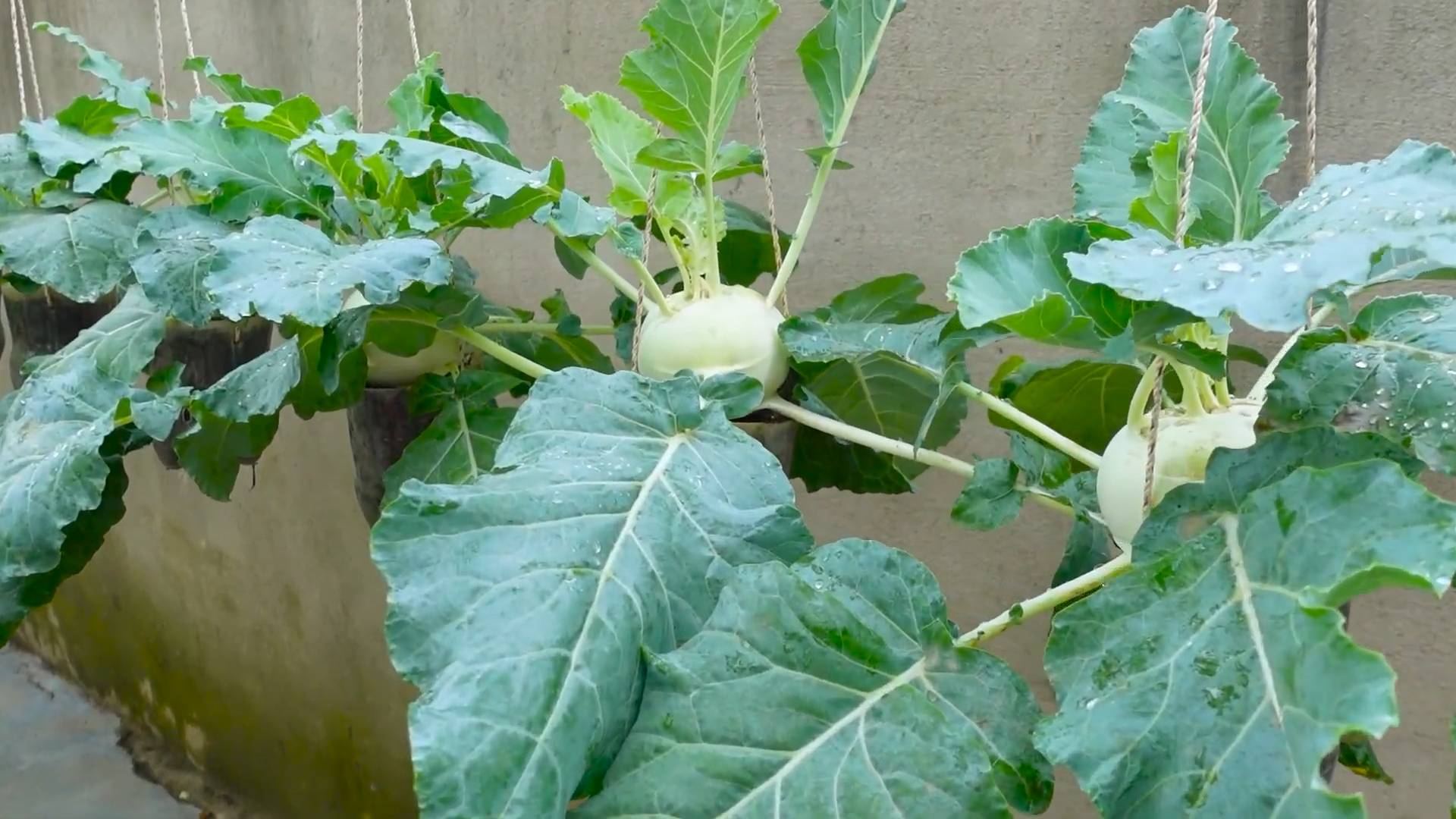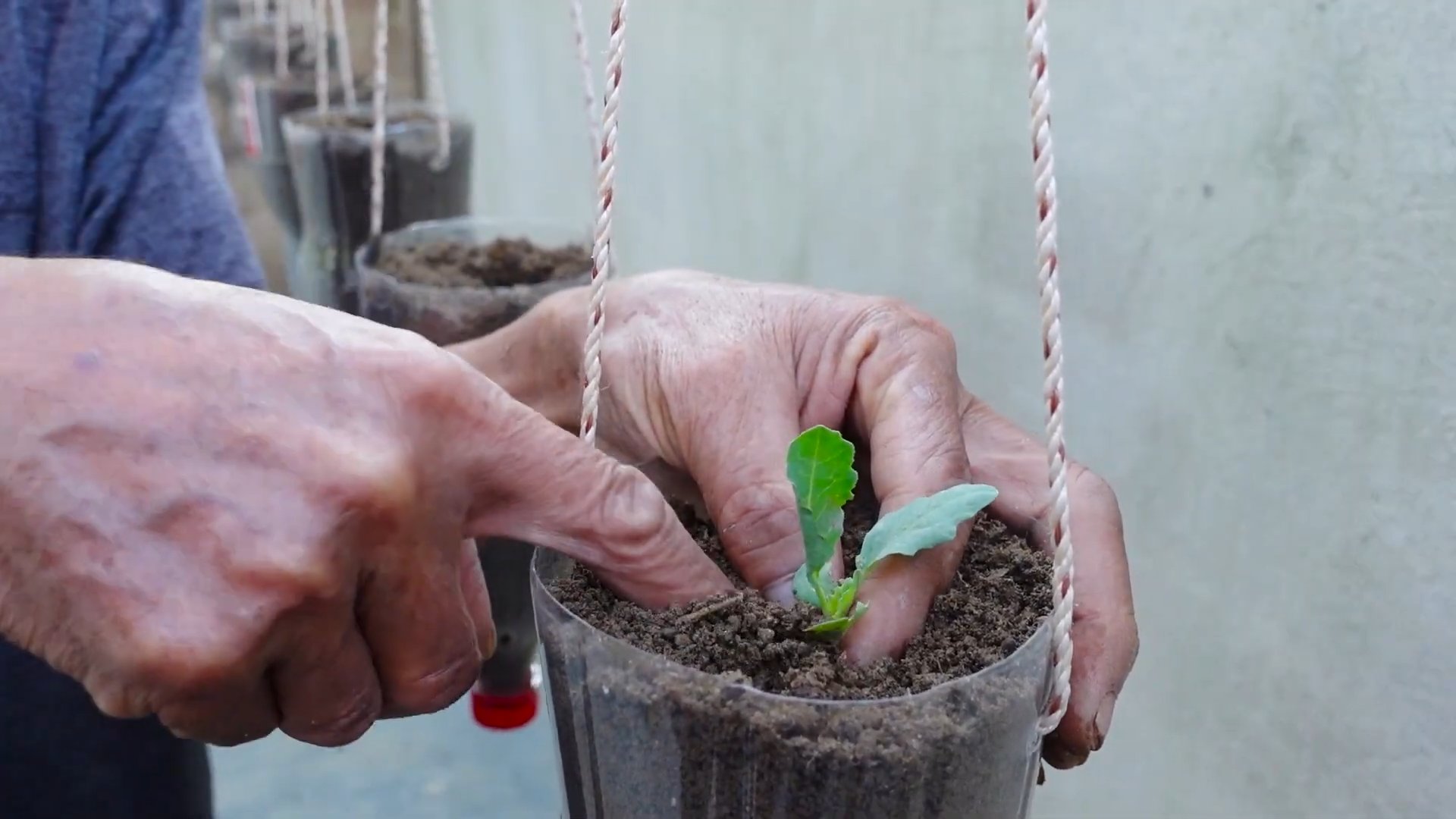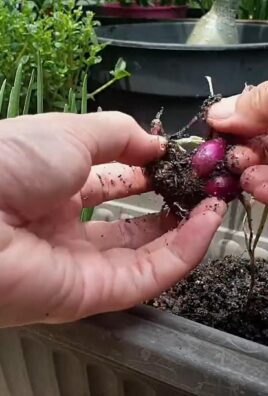Growing Kohlrabi in Pots: Unlock the secrets to cultivating this unique and delicious vegetable right on your patio or balcony! Have you ever dreamt of harvesting fresh, crisp kohlrabi just steps from your kitchen? It’s easier than you think, and this DIY guide will show you exactly how to make it happen, even if you’re short on space.
Kohlrabi, sometimes called a “German turnip,” has a fascinating history, dating back to the Roman Empire. While it might not be as widely known as its cabbage cousins, it’s a nutritional powerhouse and a culinary delight. For centuries, it’s been a staple in European and Asian cuisines, prized for its mild, slightly sweet flavor and crunchy texture.
But why should you bother growing kohlrabi in pots? Well, for starters, it’s incredibly rewarding to nurture your own food from seed to table. Plus, growing your own kohlrabi allows you to control the quality and freshness, avoiding the pesticides and long transport times often associated with store-bought produce. More importantly, many of us are living in apartments or homes with limited garden space. This DIY guide provides a practical solution, demonstrating that you don’t need acres of land to enjoy the benefits of fresh, homegrown vegetables. I’m excited to share my tips and tricks to help you successfully grow kohlrabi in pots, so let’s get started!

Growing Kohlrabi in Pots: A Beginner’s Guide
Hey there, fellow gardening enthusiasts! Ever thought about growing kohlrabi but felt intimidated by the space requirements? Well, I’m here to tell you that you absolutely CAN grow this quirky and delicious vegetable in pots! It’s easier than you think, and I’m going to walk you through every step. Get ready to enjoy fresh, homegrown kohlrabi right from your patio or balcony!
Choosing the Right Pot and Soil
First things first, let’s talk about the essentials: the pot and the soil. These are crucial for a happy and productive kohlrabi plant.
* Pot Size: Kohlrabi needs room to grow, especially its bulbous stem. I recommend a pot that’s at least 12 inches in diameter and 12 inches deep. This gives the roots enough space to spread out and the bulb to develop properly. You can go bigger, but don’t go smaller!
* Drainage: Excellent drainage is non-negotiable. Kohlrabi hates sitting in soggy soil, which can lead to root rot. Make sure your pot has drainage holes at the bottom. If it doesn’t, you can drill some yourself (carefully, of course!).
* Pot Material: Plastic, terracotta, or even fabric pots will work. Terracotta pots dry out faster, so you’ll need to water more frequently. Plastic pots retain moisture better, but be careful not to overwater. Fabric pots are great for aeration and drainage. I personally love using fabric pots!
* Soil: Forget garden soil! It’s too heavy and doesn’t drain well in containers. You need a good quality potting mix. Look for a mix that’s specifically formulated for vegetables or containers. It should be light, airy, and well-draining. I like to amend my potting mix with compost for added nutrients and moisture retention.
Sowing the Seeds
Now for the fun part: planting the seeds! You can either start your kohlrabi seeds indoors or directly sow them into your pots. I prefer direct sowing because it avoids transplant shock.
* Timing: Kohlrabi is a cool-season crop, so the best time to plant is in early spring or late summer/early fall. Check your local frost dates to determine the best time to sow. You want to avoid planting when temperatures are consistently above 75°F (24°C), as this can cause the kohlrabi to bolt (go to seed).
* Sowing Depth: Sow the seeds about ½ inch deep.
* Spacing: If you’re planting multiple kohlrabi plants in the same pot (which I don’t recommend for beginners, but it’s possible), space them about 6-8 inches apart. For a single plant, just sow a few seeds in the center of the pot and thin them out later, leaving the strongest seedling.
* Watering: Gently water the soil after sowing. Keep the soil consistently moist but not waterlogged.
Step-by-Step Instructions for Sowing Seeds:
1. Fill your chosen pot with the potting mix, leaving about an inch of space at the top.
2. Water the soil thoroughly until it’s evenly moist.
3. Make a small indentation in the soil about ½ inch deep.
4. Place 2-3 kohlrabi seeds in the indentation.
5. Cover the seeds with soil and gently pat it down.
6. Water again gently.
7. Place the pot in a sunny location.
8. Keep the soil consistently moist until the seeds germinate (usually within 5-10 days).
9. Once the seedlings emerge, thin them out, leaving only the strongest one.
Caring for Your Kohlrabi Plants
Once your kohlrabi seedlings have emerged, it’s time to provide them with the care they need to thrive.
* Sunlight: Kohlrabi needs at least 6 hours of sunlight per day. Place your pot in a sunny location where it will receive plenty of light. If you don’t have a sunny spot, you can supplement with grow lights.
* Watering: Water regularly, especially during hot and dry weather. The soil should be consistently moist but not waterlogged. Check the soil moisture by sticking your finger into the soil. If the top inch feels dry, it’s time to water.
* Fertilizing: Kohlrabi is a heavy feeder, so it needs regular fertilization. Use a balanced fertilizer (e.g., 10-10-10) every 2-3 weeks. You can also use a liquid fertilizer diluted to half strength. I personally love using compost tea as a natural fertilizer.
* Weeding: Keep the pot free of weeds. Weeds compete with your kohlrabi plants for nutrients and water.
* Pest Control: Kohlrabi can be susceptible to pests such as aphids, cabbage worms, and flea beetles. Inspect your plants regularly for signs of pests. If you find any, you can try spraying them with insecticidal soap or neem oil. You can also handpick the pests off the plants.
* Crop Rotation: While not as crucial in containers, it’s still a good idea to avoid planting kohlrabi in the same pot year after year. This can help prevent soilborne diseases.
Harvesting Your Kohlrabi
The moment you’ve been waiting for: harvesting your homegrown kohlrabi!
* Timing: Kohlrabi is typically ready to harvest about 50-60 days after planting. The ideal size for harvesting is when the bulb is about 2-3 inches in diameter. If you let it grow too large, it can become tough and woody.
* Harvesting Method: To harvest, simply cut the kohlrabi bulb from the stem with a sharp knife. Leave about an inch of stem attached to the bulb.
* Storage: Kohlrabi can be stored in the refrigerator for several weeks. Remove the leaves before storing, as they can draw moisture from the bulb.
Step-by-Step Instructions for Harvesting:
1. Check the size of the kohlrabi bulb. It should be about 2-3 inches in diameter.
2. Use a sharp knife to cut the bulb from the stem, leaving about an inch of stem attached.
3. Remove the leaves from the bulb.
4. Store the kohlrabi in the refrigerator.
Troubleshooting
Even with the best care, you might encounter some problems while growing kohlrabi. Here are some common issues and how to address them:
* Bolting (Premature Flowering): This can happen if the weather gets too hot or if the plants are stressed. To prevent bolting, plant kohlrabi in early spring or late summer/early fall, and provide consistent watering and fertilization.
* Root Rot: This is caused by overwatering and poor drainage. To prevent root rot, make sure your pot has drainage holes and don’t overwater.
* Pest Infestations: As mentioned earlier, kohlrabi can be susceptible to pests. Inspect your plants regularly and take action if you find any pests.
* Small Bulbs: This can be caused by insufficient sunlight, water, or nutrients. Make sure your plants are getting enough sunlight, water, and fertilizer.
Choosing Kohlrabi Varieties for Pots
Not all kohlrabi varieties are created equal, especially when it comes to container gardening. Some varieties are more compact and better suited for pots than others. Here are a few of my favorites:
* ‘Early White Vienna’: This is a classic variety that’s known for its early maturity and mild flavor. It’s a good choice for beginners.
* ‘Early Purple Vienna’: Similar to ‘Early White Vienna’ but with a beautiful purple skin. The flavor is just as good.
* ‘Kossak’: This is a larger variety, but it’s still suitable for pots if you use a larger container. It’s known for its excellent flavor and long storage life.
* ‘Kolibri’: A vibrant purple variety that is known for its disease resistance and compact growth habit, making it ideal for container gardening.
Tips for Success
Here are a few extra tips to help you succeed in growing kohlrabi in pots:
* Rotate Your Pots: Rotate your pots regularly to ensure that all sides of the plant receive equal sunlight.
* Mulch: Add a layer of mulch to the top of the soil to help retain moisture and suppress weeds.
* Succession Planting: Plant new seeds every few weeks to ensure a continuous harvest.
* Enjoy! Growing your own kohlrabi is a rewarding experience. Don’t be afraid to experiment and have fun!
I hope this guide has inspired you to try growing kohlrabi in pots. It’s a fun and easy way to enjoy fresh, homegrown vegetables, even if you don’t have a lot

Conclusion
So, there you have it! Growing kohlrabi in pots isn’t just possible; it’s a rewarding and surprisingly simple way to enjoy this unique vegetable, even if you’re short on garden space. We’ve walked through the entire process, from selecting the right pot and soil to nurturing your kohlrabi plants to a bountiful harvest.
But why is this DIY trick a must-try? Because it democratizes access to fresh, homegrown produce. No sprawling garden? No problem! A sunny balcony, patio, or even a well-lit windowsill can become your personal kohlrabi farm. Imagine the satisfaction of harvesting crisp, juicy kohlrabi bulbs that you nurtured from tiny seeds. The flavor is undeniably superior to store-bought varieties, and you have complete control over the growing process, ensuring your kohlrabi is free from unwanted chemicals and pesticides.
Beyond the practical benefits, growing kohlrabi in pots is a fantastic learning experience. It connects you with nature, teaches you about plant life cycles, and provides a sense of accomplishment. It’s also a great way to introduce children to gardening and healthy eating habits.
Don’t be afraid to experiment with variations! Try different kohlrabi varieties, such as the ‘Purple Vienna’ for its striking color or the ‘White Vienna’ for its classic flavor. You can also companion plant herbs like dill or chamomile in the same pot to deter pests and enhance the flavor of your kohlrabi. Consider adding a trellis for support if you’re growing a larger variety or if your plants are becoming top-heavy.
Ready to embark on your kohlrabi-growing adventure? We wholeheartedly encourage you to give this DIY trick a try. It’s easier than you think, and the rewards are well worth the effort. Remember to pay close attention to watering, fertilization, and sunlight exposure, and you’ll be well on your way to a successful harvest.
But the journey doesn’t end with the harvest. We want to hear about your experiences! Share your photos, tips, and challenges in the comments section below. What varieties did you grow? What challenges did you encounter, and how did you overcome them? Your insights can help other aspiring kohlrabi growers succeed. Let’s build a community of potted kohlrabi enthusiasts and share the joy of homegrown goodness!
And remember, even if your first attempt isn’t perfect, don’t give up! Gardening is a learning process, and every mistake is an opportunity to improve. With a little patience and persistence, you’ll be enjoying delicious, homegrown kohlrabi in no time. So, grab your pots, seeds, and soil, and get ready to experience the magic of growing kohlrabi in pots!
Frequently Asked Questions (FAQ)
What is the best size pot for growing kohlrabi?
A pot that is at least 12 inches in diameter and 12 inches deep is generally recommended for growing kohlrabi. This provides enough space for the roots to develop properly and allows the plant to access sufficient nutrients and moisture. If you plan to grow multiple kohlrabi plants in the same pot, choose a larger container accordingly, ensuring each plant has adequate space. Remember that larger pots also retain moisture better, which can be beneficial, especially in warmer climates.
What type of soil is best for growing kohlrabi in pots?
Kohlrabi thrives in well-draining, fertile soil that is rich in organic matter. A good potting mix specifically formulated for vegetables is an excellent choice. You can also create your own mix by combining equal parts of compost, peat moss (or coconut coir), and perlite or vermiculite. The compost provides essential nutrients, the peat moss or coconut coir helps retain moisture, and the perlite or vermiculite improves drainage. Avoid using garden soil, as it can be too heavy and may contain pests or diseases.
How much sunlight does kohlrabi need when grown in pots?
Kohlrabi requires at least 6 hours of direct sunlight per day to grow properly. Choose a location for your potted kohlrabi that receives ample sunlight. If you live in a particularly hot climate, some afternoon shade may be beneficial to prevent the plants from overheating. If you don’t have access to enough natural sunlight, you can supplement with grow lights.
How often should I water my potted kohlrabi plants?
Water your kohlrabi plants regularly, keeping the soil consistently moist but not waterlogged. The frequency of watering will depend on the weather conditions, the size of the pot, and the type of soil you are using. Check the soil moisture regularly by sticking your finger about an inch deep into the soil. If it feels dry, it’s time to water. Avoid overhead watering, as this can increase the risk of fungal diseases. Instead, water at the base of the plant.
What kind of fertilizer should I use for kohlrabi grown in pots?
Kohlrabi is a heavy feeder and benefits from regular fertilization. Use a balanced fertilizer with an NPK ratio of 10-10-10 or 14-14-14. You can also use a fertilizer specifically formulated for vegetables. Apply the fertilizer according to the package directions. Alternatively, you can use organic fertilizers such as compost tea or fish emulsion. These are gentler on the plants and provide a slow-release source of nutrients.
How do I protect my kohlrabi plants from pests and diseases?
Monitor your kohlrabi plants regularly for signs of pests or diseases. Common pests that affect kohlrabi include aphids, cabbage worms, and flea beetles. You can control these pests by handpicking them off the plants, using insecticidal soap, or applying Bacillus thuringiensis (Bt). Common diseases that affect kohlrabi include clubroot and downy mildew. To prevent these diseases, ensure good air circulation, avoid overhead watering, and use disease-resistant varieties.
When is the best time to harvest kohlrabi grown in pots?
Kohlrabi is typically ready to harvest when the bulb reaches a diameter of 2-3 inches. The exact time will depend on the variety and growing conditions. Check the size of the bulb regularly and harvest when it reaches the desired size. Don’t let the bulb get too large, as it can become tough and woody. To harvest, simply cut the bulb from the stem just above the soil line.
Can I grow kohlrabi in pots indoors?
Yes, you can grow kohlrabi in pots indoors, but it requires providing the plants with adequate light. A sunny south-facing window or grow lights are essential. Ensure the plants receive at least 6 hours of light per day. Also, maintain a consistent temperature and humidity level. Indoor growing can be more challenging than outdoor growing, but it is possible with the right conditions.
What are some good companion plants for kohlrabi in pots?
Companion planting can benefit kohlrabi by deterring pests, attracting beneficial insects, and improving soil health. Good companion plants for kohlrabi include dill, chamomile, rosemary, thyme, and nasturtiums. Avoid planting kohlrabi near other members of the brassica family, such as broccoli, cabbage, and cauliflower, as they can attract the same pests and diseases.
My kohlrabi bulb is cracking. What could be the cause?
Cracking in kohlrabi bulbs is often caused by inconsistent watering. Periods of drought followed by heavy watering can cause the bulb to swell rapidly, leading to cracks. To prevent cracking, ensure consistent watering and avoid letting the soil dry out completely. Mulching around the plants can also help retain moisture and prevent fluctuations in soil moisture levels.





Leave a Comment